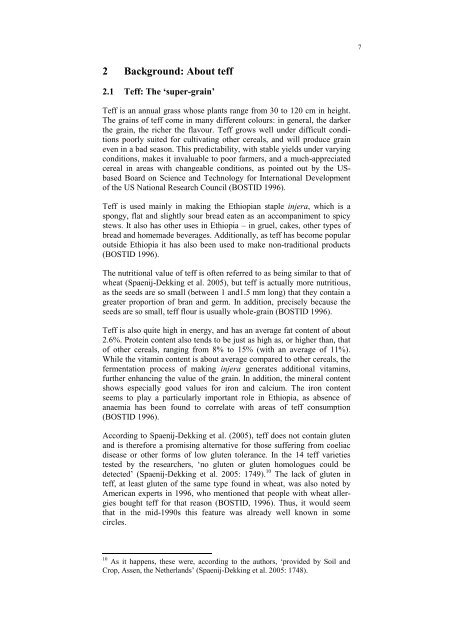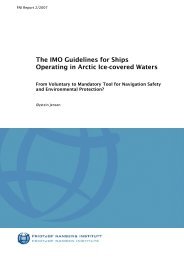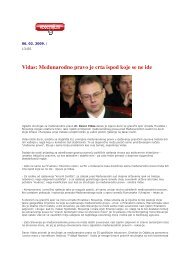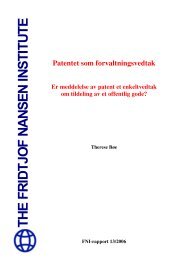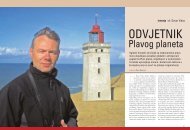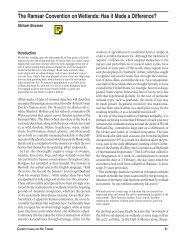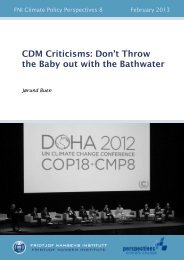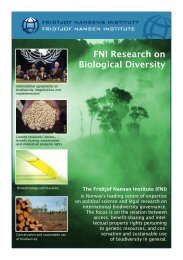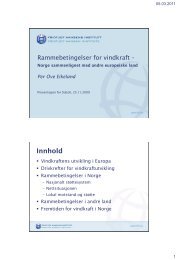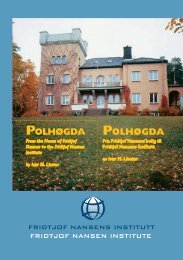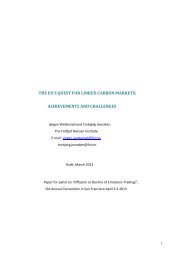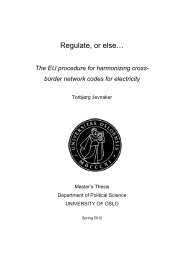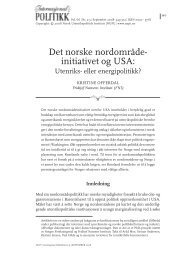The Access and Benefit-Sharing Agreement on Teff Genetic - Fridtjof ...
The Access and Benefit-Sharing Agreement on Teff Genetic - Fridtjof ...
The Access and Benefit-Sharing Agreement on Teff Genetic - Fridtjof ...
Create successful ePaper yourself
Turn your PDF publications into a flip-book with our unique Google optimized e-Paper software.
7<br />
2 Background: About teff<br />
2.1 <strong>Teff</strong>: <str<strong>on</strong>g>The</str<strong>on</strong>g> ‘super-grain’<br />
<strong>Teff</strong> is an annual grass whose plants range from 30 to 120 cm in height.<br />
<str<strong>on</strong>g>The</str<strong>on</strong>g> grains of teff come in many different colours: in general, the darker<br />
the grain, the richer the flavour. <strong>Teff</strong> grows well under difficult c<strong>on</strong>diti<strong>on</strong>s<br />
poorly suited for cultivating other cereals, <str<strong>on</strong>g>and</str<strong>on</strong>g> will produce grain<br />
even in a bad seas<strong>on</strong>. This predictability, with stable yields under varying<br />
c<strong>on</strong>diti<strong>on</strong>s, makes it invaluable to poor farmers, <str<strong>on</strong>g>and</str<strong>on</strong>g> a much-appreciated<br />
cereal in areas with changeable c<strong>on</strong>diti<strong>on</strong>s, as pointed out by the USbased<br />
Board <strong>on</strong> Science <str<strong>on</strong>g>and</str<strong>on</strong>g> Technology for Internati<strong>on</strong>al Development<br />
of the US Nati<strong>on</strong>al Research Council (BOSTID 1996).<br />
<strong>Teff</strong> is used mainly in making the Ethiopian staple injera, which is a<br />
sp<strong>on</strong>gy, flat <str<strong>on</strong>g>and</str<strong>on</strong>g> slightly sour bread eaten as an accompaniment to spicy<br />
stews. It also has other uses in Ethiopia – in gruel, cakes, other types of<br />
bread <str<strong>on</strong>g>and</str<strong>on</strong>g> homemade beverages. Additi<strong>on</strong>ally, as teff has become popular<br />
outside Ethiopia it has also been used to make n<strong>on</strong>-traditi<strong>on</strong>al products<br />
(BOSTID 1996).<br />
<str<strong>on</strong>g>The</str<strong>on</strong>g> nutriti<strong>on</strong>al value of teff is often referred to as being similar to that of<br />
wheat (Spaenij-Dekking et al. 2005), but teff is actually more nutritious,<br />
as the seeds are so small (between 1 <str<strong>on</strong>g>and</str<strong>on</strong>g>1.5 mm l<strong>on</strong>g) that they c<strong>on</strong>tain a<br />
greater proporti<strong>on</strong> of bran <str<strong>on</strong>g>and</str<strong>on</strong>g> germ. In additi<strong>on</strong>, precisely because the<br />
seeds are so small, teff flour is usually whole-grain (BOSTID 1996).<br />
<strong>Teff</strong> is also quite high in energy, <str<strong>on</strong>g>and</str<strong>on</strong>g> has an average fat c<strong>on</strong>tent of about<br />
2.6%. Protein c<strong>on</strong>tent also tends to be just as high as, or higher than, that<br />
of other cereals, ranging from 8% to 15% (with an average of 11%).<br />
While the vitamin c<strong>on</strong>tent is about average compared to other cereals, the<br />
fermentati<strong>on</strong> process of making injera generates additi<strong>on</strong>al vitamins,<br />
further enhancing the value of the grain. In additi<strong>on</strong>, the mineral c<strong>on</strong>tent<br />
shows especially good values for ir<strong>on</strong> <str<strong>on</strong>g>and</str<strong>on</strong>g> calcium. <str<strong>on</strong>g>The</str<strong>on</strong>g> ir<strong>on</strong> c<strong>on</strong>tent<br />
seems to play a particularly important role in Ethiopia, as absence of<br />
anaemia has been found to correlate with areas of teff c<strong>on</strong>sumpti<strong>on</strong><br />
(BOSTID 1996).<br />
According to Spaenij-Dekking et al. (2005), teff does not c<strong>on</strong>tain gluten<br />
<str<strong>on</strong>g>and</str<strong>on</strong>g> is therefore a promising alternative for those suffering from coeliac<br />
disease or other forms of low gluten tolerance. In the 14 teff varieties<br />
tested by the researchers, ‘no gluten or gluten homologues could be<br />
detected’ (Spaenij-Dekking et al. 2005: 1749). 10 <str<strong>on</strong>g>The</str<strong>on</strong>g> lack of gluten in<br />
teff, at least gluten of the same type found in wheat, was also noted by<br />
American experts in 1996, who menti<strong>on</strong>ed that people with wheat allergies<br />
bought teff for that reas<strong>on</strong> (BOSTID, 1996). Thus, it would seem<br />
that in the mid-1990s this feature was already well known in some<br />
circles.<br />
10 As it happens, these were, according to the authors, ‘provided by Soil <str<strong>on</strong>g>and</str<strong>on</strong>g><br />
Crop, Assen, the Netherl<str<strong>on</strong>g>and</str<strong>on</strong>g>s’ (Spaenij-Dekking et al. 2005: 1748).


